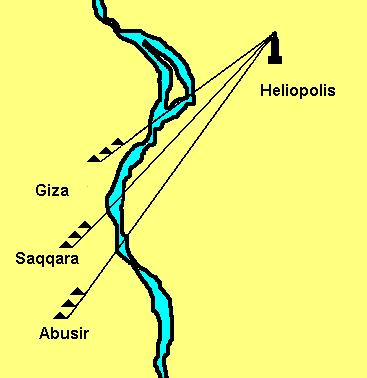|
Location:
30km South of Cairo, Egypt. |
Grid Reference:
29.978� N, 31.216� E. |
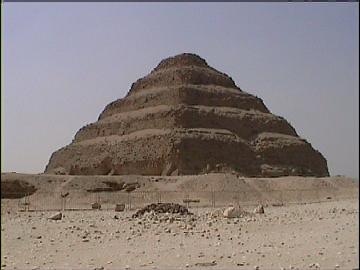
 Saqqara:
('Stepped Pyramid', 'Ziggurat').
Saqqara:
('Stepped Pyramid', 'Ziggurat').
The stepped pyramid of Djoser at Saqqara is believed to be the
first of its kind in the world.
Saqqara was the
necropolis and sacred
centre for the great city of Memphis, the remains of which can be seen
nearby. This great city was founded about 3,000 B.C. by the
first pharaoh of Egypt.
The name Serapeum is most often used to refer to the
burial place of the sacred Apis bulls at Saqqara. It consisted of a
huge underground complex to the north-west of the Step Pyramid of
Djoser where the bulls were buried in enormous granite sarcophagi
between the 18th
Dynasty and Ptolemaic times.
Article:
Saqqara - Home of the
Oldest Known Papyrus Roll (c. 2,900 B.C).
"The ancient Egyptians had used rolls made of
papyrus from the early days of the Old Kingdom. The oldest known
papyrus roll was found in the tomb of Hemaka in Saqqara, and dates to
the 1st dynasty, around 2900 BC. The hieroglyph for 'papyrus roll'
existed already in inscriptions from this period. The 1st dynasty roll
was blank; the oldest examples with writing dated from the 4th and 5th
dynasties"
(Ref: Roemer, "The Papyrus Roll in
Egypt, Greece, and Rome," Eliot & Rose (eds) A Companion to the
History of the Book [2007] 84).
|
Saqqara:
(Sakkara, Saqqarah) |
Description - As well as the famous step-pyramid of Djoser (Zoser), the Saqqara complex
includes numerous other funerary structures that date back from the first
dynasty. Saqqara represents the first complete model of the typical pyramid
complex including enclosure walls and a causeway.
The oldest mastaba-tombs in Saqqara are build
in the time of Aha in the northern spur of Saqqara
(2)
D joser's (Zoser)
Step-pyramid:
The
step pyramid is believed to have been initiated by the third dynasty pharaoh Djoser and designed by
his vizier Imhotep.
It is considered by Egyptologists to be the
Oldest Pyramid in the world.
The Step-pyramid is believed to have evolved from an original 'Mastaba'
form which was later built upon and extended several times until it
attained its present shape. It was built from local limestone and cased
in the better quality Tura limestone.
(1)
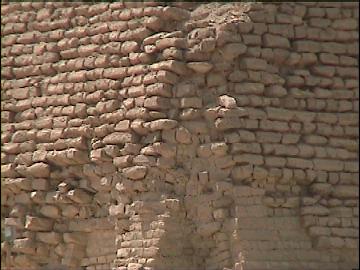
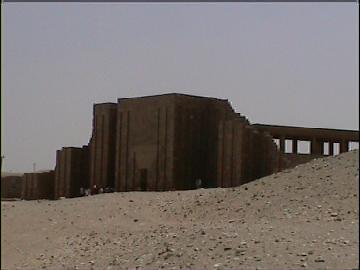
Djoser's step-pyramid was built with
mud-fired bricks,
then surrounded by a recessed outer wall that surrounded the whole
complex.
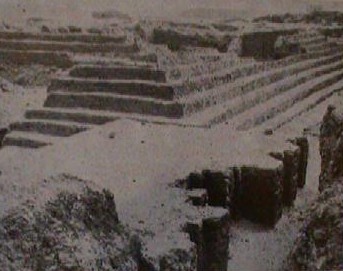
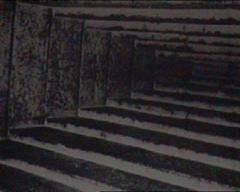
The 'stepped' theme is seen
in a first dynasty tomb (left), from Saqqara - note the similar buttress
walls, and is repeated in the shape of the internal corbelled roofs of the
fourth dynasty (right). An excellent example of
negative space
construction.
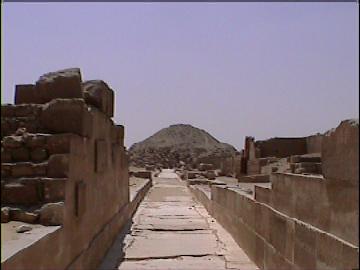
The first Causeway in the world.
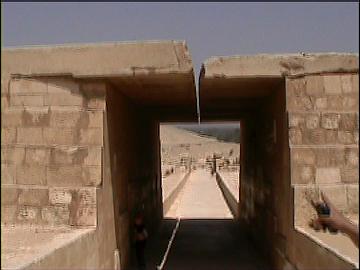
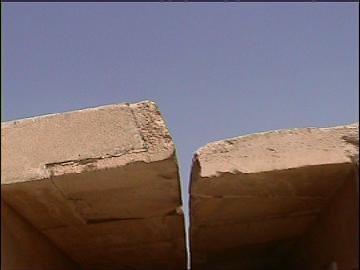
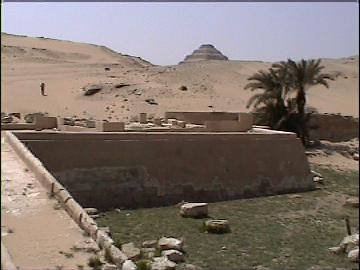
The causeway is
believed to have been originally covered along its whole length.
(The ceiling was originally completely
covered with painted stars.)
|
News Article:
Seattle Times. June 6th. 2008.
'Egyptian archaeologists have uncovered the
"missing pyramid" of a pharaoh and a ceremonial procession road
where high priests carried mummified remains of sacred bulls,
Egypt's antiquities chief said earlier this year'.
Zahi Hawass said the pyramid � of which only
the base remains � is believed to be that of King Menkauhor, an
obscure pharaoh who ruled for only eight years more than 4,000
years ago.
(Click here for more on this subject) |
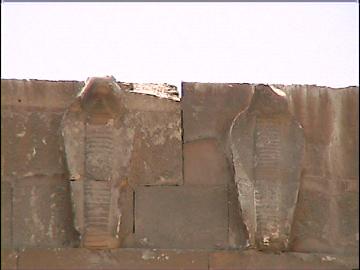
Evidence of serpent worship
at Saqqara.
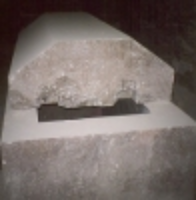 The
Serapium: The
Serapium:
The Serapeum is the term most often used to
refer to the burial place of the sacred Apis bulls at Saqqara. It
consisted of a huge underground complex to the north-west of the Step
Pyramid of Djoser where the bulls were buried in enormous granite
sarcophagi between the 18th Dynasty and Ptolemaic times.
Extract from Strabo: "One finds a
temple to Serapis in such a sandy place that the wind heaps up the sand
dunes beneath which we saw sphinxes, some half buried, some buried up to
the head, from which one can suppose that the way to this temple could not
be without danger if one were caught in a sudden wind storm. It was
impossible to doubt it. This buried Sphinx, the companion of fifteen
others I had encountered in Alexandria and Cairo, formed with them,
according to the evidence, part of the avenue that led to the Memphis
Serapeum...
It did not seem to me possible to leave to others the credit and profit of
exploring this temple whose remains a fortunate chance had allowed me to
discover and whose location henceforth would be known. Undoubtedly many
precious fragments, many statues, many unknown texts were hidden beneath
the sand upon which I stood. These considerations made all my scruples
disappear. At that instant I forgot my mission (obtaining Coptic texts
from the monasteries), I forgot the Patriarch, the convents, the Coptic
and Syriac manuscripts, Linant Bey himself, and it was thus, on 1 November
1850, during one of the most beautiful sunrises I had ever seen in Egypt,
that a group of thirty workmen, working under my orders near that sphinx,
were about to cause such total upheaval in the conditions of my stay in
Egypt."
The sacred bulls were buried in a single block of granite that weighed
between sixty and eighty tons. All twenty-four sarcophagi had been
plundered. Their lids had been praised loose and the contents taken.
Further excavation revealed an older gallery and then another one further
on. The way into the first of the galleries was blocked by a huge rock
which was blown apart with explosives. Beneath where the rock had been,
was found a mummy of a man. This was the mummy of a son of Ramasses II,
Prince Khaemwese. He was in charge of the restoration of the Pyramid of
Unas. He was also governor of Memphis and a high priest of Ptah. He had
requested to be buried with the sacred bulls rather than a tomb of his
own.
The mastabas at Saqqara display some interesting
features. Three of the tombs had an associated mud-brick boat burial on
their north side and some of the mastabas also had raised platforms which
ran around them. The heads were modelled out of mud but the horns were real,
and it has been estimated that a tomb might have been surrounded by up to
three hundred of them. Throughout Egyptian history the bull was closely
associated with kinship. The pharaoh was referred to as 'Mighty Bull'
(1).
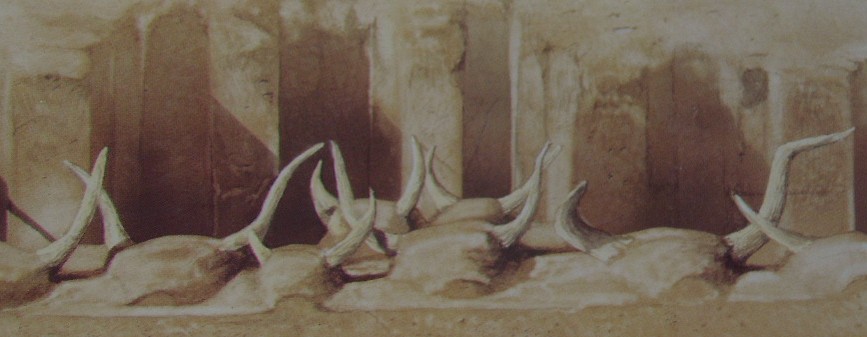
Bull Worship at Saqqara -
(The facade of tomb 3504)...
The superstructure of the tomb
shows evidence of 30 niches and 34 projections along its
periphery. The structure was built on a wide platform on which,
placed at reguar intervals, were clay bovine heads with real
horns. At the rate of 7 to each niche and 4 on the facade, there
would have been a total of 346. The bull played a considerable
role in the Old kingdom, and in the pyramid texts the King is
often called 'The Bull of the Sky'. But because of its horns the
bull was also related to the moon. Thus it is tempting to note
that the number of bull heads here approximates to that of 12
lunations (354 days), and extremely close to the number of days
which Sir Fred Hoyle related to the periodic return of eclipses.
(3)
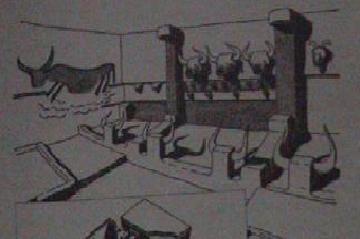
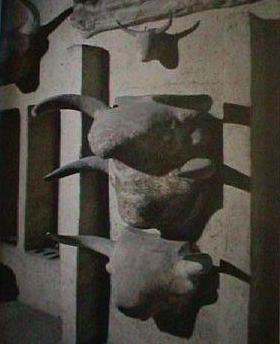
Bull worship at
at Chatal Huyak, Turkey.
(It is suggested that the ' Metsamorian'
culture may have been predecessors to the Egyptian culture).
(More
about Metsamor)
(Other Egyptian Sites) |










 The
Serapium:
The
Serapium:



